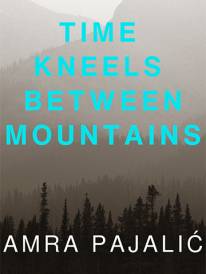Jennifer Lawrence X-Men: Apocalypse
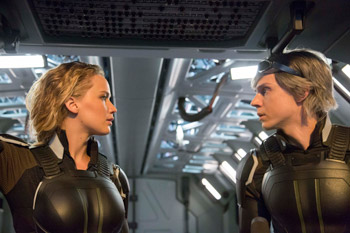
Jennifer Lawrence X-Men: Apocalypse
Cast: Jennifer Lawrence, Rose Byrne, Oscar Isaac, Olivia Munn, James McAvoy, Michael Fassbender, Evan Peters
Director: Bryan Singer
Genre: Action, Adventure
Rated: M
Running Time: 144 minutes
Synopsis: Following his acclaimed work on X-Men: Days Of Future Past, director Bryan Singer takes the franchise to new heights with X-Men: Apocalypse, in which the X-Men battle the original and most powerful mutant - Apocalypse.
In 1983, the invincible and immortal Apocalypse is set free after being entombed for several millennia. Enraged that his kind are no longer treated as gods, Apocalypse assembles a team of powerful mutants, including a disheartened Magneto, to destroy humankind and create a new world order, over which he will reign.
To end Apocalypse's path of global destruction, Raven (Jennifer Lawrence) and Professor X (James McAvoy) lead a team of young X-Men in an epic showdown with a seemingly unstoppable enemy.
X-Men: Apocalypse
Release Date: May 19th, 2015
About The Production
Apocalypse Now…And Then
The critically hailed blockbuster X-Men: Days Of Future Past was a tough act to follow. Moreover, the filmmakers' goal was to not only live up to the expectations set by that film, but to exceed them. 'We had a real challenge to come up with a story that could surpass Days Of Future Past in terms of scale and stakes," notes writer-producer Simon Kinberg, who served in those capacities on that film.
A creative breakthrough came with the decision to have the new film's antagonist be the most powerful mutant villain in the entire X-Men universe. 'Apocalypse poses a cosmic threat and that sense of scale appealed to Bryan Singer and me," Simon Kinberg adds.
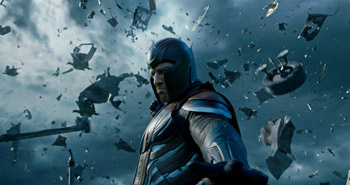 Of course, Bryan Singer's embrace of the character was critical. He reinvented the comic book genre as we've come to know it with the debut of the successful X-Men in 2000, followed by the blockbuster X2 in 2003. With those films, and then years later with X-Men: Days Of Future Past, Singer seamlessly fused character-driven drama, science fiction, action and adventure.
Of course, Bryan Singer's embrace of the character was critical. He reinvented the comic book genre as we've come to know it with the debut of the successful X-Men in 2000, followed by the blockbuster X2 in 2003. With those films, and then years later with X-Men: Days Of Future Past, Singer seamlessly fused character-driven drama, science fiction, action and adventure.
Bryan Singer was particularly drawn to Apocalypse's self-designation as a god. 'I was fascinated by the notion of ancient mutant powers, and what a mutant would think if he or she was born 20,000 or 30,000 years ago. They would, of course, think they were a god, and would behave as one. And they would be looked at and worshipped like a god.
'Apocalypse believed that it was his responsibility to build a society and to remove humanity's innate savagery. Over the millennia, Apocalypse had done this many times"with, for example, the Babylonians, Arcadians, Sumerians"and he'd been called many gods over many lifetimes."
'Bryan Singer kicked the door down on history to bring this incredible villain back from such a distant point in history," says producer Hutch Parker. Indeed, long before the world was aware of mutants, Apocalypse ruled as a god. Actually, 'he imagines himself not just as a god, but as the god," says Simon Kinberg. 'That's a very rich idea for a villain. It's not a man versus mutant struggle, as we've seen in other films; it's a world Apocalypse has envisioned, where only the strong survive."
'He's a threat unlike any the X-Men have known," adds Hutch Parker. 'Apocalypse is both ancient and otherworldly."
Given Apocalypse's vision of global destruction, it's no surprise that this is the most visually ambitious of the X-Men pictures. 'We're not only traveling the world, we're talking about the potential end of the world, and perhaps the end of the universe," says director of photography Newton Thomas Sigel, who previously collaborated with Bryan Singer on X-Men: Days Of Future Past, X2, and X-Men, among other films. Adds Oscar Isaac, who plays the seminal figure: 'The stage is set for an epic mutant versus mega-mutant war. The battle between the X-Men and Apocalypse is insane!"
Moviegoers got their first glimpse of Apocalypse in a post-end credits sequence in X-Men: Days Of Future Past, where a younger version of the mutant was seen building pyramids, telepathically, while his minions looked on.
Apocalypse's 5,000-year absence began when civilization was at its peak; his sleep ends when it's arguably at its nadir. Upon rising in Cairo in 1983 from his millennia-long slumber, Apocalypse is shocked and repulsed by our planet's decline"the cars, noise, pollution"all signs of a failed world that he must cleanse. His mission: exterminate the weak and rebuild it for the strong.
'It's a time of conflict, war and destruction," notes Bryan Singer. 'Apocalypse sees this as a civilization in desperate need of culling. There are false idols: people now worship money, and possess nuclear weapons, which gives them a false sense of godlike power. This does not work for Apocalypse. So he wants to put an end to it and start everything fresh again"and to reshape Earth in his image."
Having grown up in the eighties, Simon Kinberg understood how it was marked by excess, as seen in the hairstyles, fashion, and automobiles. 'In 1983, Apocalypse rises from the perfection of ancient Egyptian culture into an over-populated, polluted, nuclear-threatened culture," he says. '
So his motivation is understandable, though his methods and goals are extreme." Oscar Isaac, who took on the role of Apocalypse following his star turn as the heroic starfighter pilot Poe Dameron in Star Wars: The Force Awakens, calls the character nothing less than 'the creative/destructive force of this earth. When things seem like they're no longer evolving"like they did in the 1980s"he destroys those civilizations."
Bryan Singer considered and then rejected the notion of making the character a giant, at least for most of the movie. 'You will see him bigger than life, so there'll be that satisfaction," he explains. 'But I also felt Apocalypse needed to exert his powers of persuasion. That's why I went with a really fine actor"Oscar Isaac"instead of just throwing him in a digital costume and animating him. There are some pretty spectacular things that occur, but it was important to feel a sense of realness"that Apocalypse is a physical being. I never wanted to lose the actor inside of CG animation."
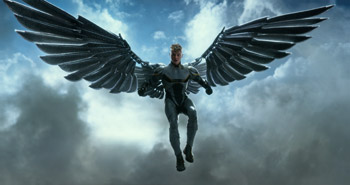 The role required a juxtaposition of cruelty and violence with a unique kind of humanity. It's a delicate balance that Isaac executes with consummate skill. 'Oscar Isaac as all of the different colors of the greatest actors," says Simon Kinberg. Adds Hutch Parker: 'Oscar Isaac has such authenticity and dramatic integrity that he's really one of the anchors of the film"playing the character around which everything pivots."
The role required a juxtaposition of cruelty and violence with a unique kind of humanity. It's a delicate balance that Isaac executes with consummate skill. 'Oscar Isaac as all of the different colors of the greatest actors," says Simon Kinberg. Adds Hutch Parker: 'Oscar Isaac has such authenticity and dramatic integrity that he's really one of the anchors of the film"playing the character around which everything pivots."
Raven, Charles And Erik: Hope, Despair And Armageddon
The world of 1983 also has undergone upheavals in the treatment of mutants. This next stage of human evolution is now accepted by most"but not all"of humanity, thanks to the heroism of Raven/Mystique, who (as seen in X-Men: Days Of Future Past) prevented the assassination of the U.S. president and a war between mutants and humans.
Raven, a blue-skinned shapeshifter, is seeking her true purpose, as well as elusive self-acceptance. In the years leading up to X-Men: Apocalypse, she had tried to stay hidden from the world, shunning her celebrity as the face of hope and change for the new, mutant-integrated world. She resists bearing the weight of that label, and feels much of her past doesn't warrant the world's perception of her as a hero.
Now, Raven is living by her own code and working independently as an underground mutant savior, to fight against the remaining instances of human exploitation of mutants and save those still being persecuted.
'The character is more -Raven' than -Mystique' in this story because she cannot be her true mutant self in a world that she feels is still not as mutant-friendly as it's perceived to be," says Oscar®-winner Jennifer Lawrence, who first played the role in X-Men: First Class and then reprised it in X-Men: Days Of Future Past. 'That's why she has basically been Raven since the events of the previous films, so no one would know she's that mutant. When we meet her in this film, she's been living a covert life as Raven."
Raven's mission to help mutants where she can culminates in her leading the X-Men in a massive battle with Apocalypse. But first she is reunited with the two men with whom she is closest, and with whom she shares a complex and evolving history: Charles Xavier (aka Professor X) and Erik Lensherr (Magneto). Raven and Charles have a long history together and were part of the original X-Men team. In the subsequent years they grew apart, separated by both distance and philosophies.
When they are reunited, Raven's views conflict with Charles's. 'She still does not believe people will embrace mutants; she's seen the darker side of it," Bryan Singer explains. 'So Raven confronts Charles on it. He has no intention of forming a fighting force of any kind. They have polarizing views of where the world has come in the past ten years and how that leads to the formation of the X-Men."
When we meet Charles in X-Men: Apocalypse, he has rededicated himself to building his School for Gifted Children, as a safe haven for mutants learning how to control their powers.
Within the context of Marvel's universe, Simon Kinberg sees Xavier's school as a radical idea. 'It's a guy who takes a bunch of kids, trains them in a -Danger Room' in his basement, plus they wear costumes, and go around the world stopping evil and injustice. Instead of shying away from that idea, we wanted to explore and embrace how radical the X-Men are," he explains.
Xavier is a powerful telepath whose greatest gift, says James McAvoy, who reprises the role, is 'his empathy and ability to teach. The events of the last film left him hopeful and more responsible."
Xavier's optimism and hope in 1983 is a 180-degree turn from the broken figure of X-Men: Days Of Future Past. 'He's surrounded by brilliant young students, and is now able to look past the prejudice, fear and hatred that linger in the world," says James McAvoy. But his thinking undergoes another evolution after Apocalypse begins his reign of terror and destruction. 'Xavier's worst fears begin to surface and he has to mature to the realities of a world in the hands of an evil mutant," James McAvoy adds. 'In some ways he has to become more militant"and more like Magneto."
James McAvoy is referring, of course, to Xavier's closest friend and fiercest rival, who, when we catch up with him in X-Men: Apocalypse is finally living in peace. Failing in his attempt to assassinate the U.S. president at the end of Days Of Future Past, Magneto has disappeared, his silence and absence benefiting the progress of mutant integration into society.
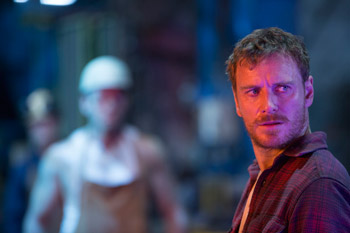 Over a decade later, 'he's hung up his cape and evil ways," says recent Oscar nominee Michael Fassbender, who again takes on the role of the powerful mutant. Magneto is living a quiet life in a small town in Poland. He has a wife and a young daughter, and a job at local steel factory. But when a confrontation with local authorities ends tragically, Magneto's tranquil life is shattered and his heart is broken. 'Magneto had chosen to mimic the life of his parents, living and working in his native land, Poland," says Bryan Singer. 'But it goes horribly wrong, and he is devastated and takes an apocalyptic turn."
Over a decade later, 'he's hung up his cape and evil ways," says recent Oscar nominee Michael Fassbender, who again takes on the role of the powerful mutant. Magneto is living a quiet life in a small town in Poland. He has a wife and a young daughter, and a job at local steel factory. But when a confrontation with local authorities ends tragically, Magneto's tranquil life is shattered and his heart is broken. 'Magneto had chosen to mimic the life of his parents, living and working in his native land, Poland," says Bryan Singer. 'But it goes horribly wrong, and he is devastated and takes an apocalyptic turn."
Destroy
Once again fueled by rage and revenge, Magneto is vulnerable to Apocalypse's offer to join him as one of his newly reformed Four Horsemen. Inspired by the biblical vision of Four Horsemen, who unleash a divine destruction upon the world, Apocalypse's Four Horsemen are minion mutants who, says Michael Fassbender, 'are living on the margins and have been ostracized or bullied."
Apocalypse's Four Horsemen, circa 1983, are: Magneto, Psylocke, Angel and Storm. Psylocke, portrayed by Olivia Munn, is a powerful telepath and trained ninja assassin. We meet her as the bodyguard for Caliban, an underground mutant tracker. Apocalypse senses Psylocke's power and persuades her to join his cause. 'She's a fascinating character," says Olivia Munn. 'Unlike many of her fellow mutants, who kill only when they must, Psylocke has always enjoyed killing, or at least she has no problem doing it."
Olivia Munn, who is a fan of the comics character, says that Psylocke has always had substantive plot lines"'she's a skilled fighter, and strong and fierce. She's a badass character presenting real female power."
Storm (whose given name is Ororo Monroe) is an orphan raised as a thief on the streets of Cairo. Portrayed by Alexandra Shipp, Storm possesses the ability to control all aspects of the weather. Storm can also fly, thanks to her ability to control wind currents. While she will become one of the most valued leaders of the X-Men, the Storm we meet in this film is struggling with her identity, before Apocalypse convinces her to join his team.
'This Storm is more reckless and emotionally driven than the adult Storm we know from the previous X-Men films, starring Halle Berry," says Aleandra Shipp. 'She's confused about who she wants to be, and her lack of opportunity leads her to join Apocalypse as one of his modern Horsemen."
The Fourth Horseman is Angel, whose mutation gave him large wings and the ability to fly. Angel's agility, strength and reflexes make him a lethal hand-to-hand combatant.
In X-Men: Apocalypse, after suffering severe damage to his wings, Angel is like an angry punk rocker. He's a drunk, disheveled mess, and surviving out of pure instinct. We meet him as the champion of the underground fighting cages in East Berlin. Angel is approached by Apocalypse, who gives him the opportunity to channel his anger and join his Horsemen. The über-mutant finds a willing acolyte in Angel, who is looking for reason to live, instead of just a reason to kill. In exchange for his allegiance, Apocalypse repairs Angel's wings by transforming them into a techno-organic metal, which allows him to shoot deadly razor projectiles from his now indestructible wings.
Ben Hardy, who takes flight as Angel, knew the character is one of the most anticipated by fans, and worked hard to bring Angel to life. That included a rigorous training regimen. en Hardy trained six days a week and followed a strict diet, 'to look as superhuman as possible," he says. For flying scenes, Hardy trained for and executed complicated stunt wire-work, an often dizzying experience. 'I mean, to be 30 feet in the air and swoop down was like being on a rollercoaster all day," says Hardy.
Defend
While Apocalypse is assembling his Horsemen, Charles is teaching and training his young students. When Apocalypse's rampage hits home, the young men and women must grow up quickly; as Raven tells them, 'You're not students, anymore; you're X-Men."
Many of those characters will be familiar to audiences, but we meet them in this film as younger incarnations of the iconic figures in the original X-Men films. Singer says bringing these versions of the characters to life was one of the highlights of creating X-Men: Apocalypse. 'The world has embraced mutants, somewhat, and this film not only introduces new characters, it forms the team and explains why X-Men were necessary. They're not just students who attend Xavier's school. I understand some of them feel like outcasts and want to belong in a place where they're accepted. But why a fighting force of mutants? What's the need for that? This film tells that story."
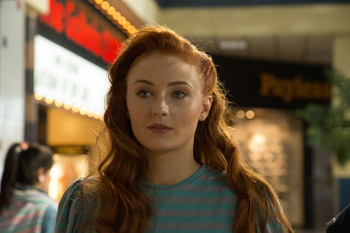 Jean Grey (Sophie Turner) has the dual powers of telepathy and telekinesis. But as a teenager, Jean's powers are out of control and she must put them in check for her own safety and the safety of the other students at Charles' school. Recognising Jean's potential, Charles takes her under his wing, much as he did with Raven (in X-Men: First Class). James McAvoy says Charles and Jean share a powerful connection because 'he understands how hard it is to switch the power on and off."
Jean Grey (Sophie Turner) has the dual powers of telepathy and telekinesis. But as a teenager, Jean's powers are out of control and she must put them in check for her own safety and the safety of the other students at Charles' school. Recognising Jean's potential, Charles takes her under his wing, much as he did with Raven (in X-Men: First Class). James McAvoy says Charles and Jean share a powerful connection because 'he understands how hard it is to switch the power on and off."
Even with Charles' tutelage, Jean's adjustment to the school and her fellow mutants is not an easy one. 'Jean feels alienated," says Sophie Turner. 'She's at a school for mutants, but she can't fully control her powers and the other students are either afraid of her or think she's a freak."
Things begin to change when Jean meets classmate Scott Summers, played by Tye Sheridan, with whom she begins to develop a bond, and she blossoms. It's a dynamic, says Simon Kinberg, which is the 'origin of their love story."
But first, Scott (aka Cyclops) must come to terms with his own powers, which allow him to shoot powerful optic blasts that can only be contained by wearing custom ruby quartz glasses. While fans know that Scott is destined to become a leader of the X-Men, he is a much different person upon manifestation of his powers in 1983. Skinny, awkward and full of teen angst, Scott also has a chip on his shoulder towards his older brother Alex (Lucas Till), also known as Havok, whom we met in X-Men: First Class.
Scott, like so many of his mutant brethren, initially feels like he doesn't fit in. 'He has a blunt sense of humor," says Tye Sheridan, but notes Jean quickly changes his dark outlook. 'Scott and Jean have this awkward, slightly provocative and flirtatious first encounter, which is the foundation of what becomes a very important relationship."
It is Hank McCoy/Beast who designs a combat-appropriate visor for Scott, which finally allows him to control the force of his optic blasts. It's all in day's work for Hank, a genius-level intellect who, as Beast, possesses uncommon ferocity, enhanced strength, speed and agility.
Hank spent the past ten years helping to rebuild and open Xavier's School for the Gifted. Says Nicholas Hoult, who again takes on the role he first portrayed in X-Men: First Class: 'Hank is continuing to build gadgets and gizmos, improving Cerebro, and crafting a supersonic, blast-resistant jet. He enjoys being a teacher and having young mutants around."
Those young mutants include Peter Maximoff/Quicksilver, who is gifted with extreme speed. He was one of the breakout characters from Days Of Future Past, thanks to a show-stopping and visually arresting sequence where Quicksilver runs along the walls in the Pentagon kitchen, parallel to the ground, as part of a successful effort to free Magneto from a seemingly impregnable prison.
Audiences had never experienced anything like it on film before. But a Quicksilver-centric scene in X-Men: Apocalypse tops it. 'The fun of building the new scene was coming up with the Quicksilver philosophy, which is that he can move so fast, he can fit a day's activity into the blink of an eye," says visual effects supervisor John Dykstra. Adds Evan Peters, who reprises his X-Men: Days Of Future Past role: '-Quicksilver time' exists within its own set of laws. He moves so fast that time seems to stop, but it is taxing for him."
The new sequence required the use of various cameras, such as the Phantom and the Red, shooting at various speeds, sometimes as high as 3200 frames per second. Still images were also integrated into the composite. 'It's a two-minute sequence that took us over a month and half to shoot," says Bryan Singer, 'and it uses some of today's most sophisticated technology. 'It has a different feel from the scene in Days Of Future Past, and it might be a little bittersweet. It's definitely unique."
The hyper-kinetic action complements the character's increased profile in this new story. But some things never change: mutants have been living openly among humans for a decade, but Quicksilver is still living in his mother's basement. 'He's a bit depressed," says Evan Peters. 'Peter's room is now a little cleaner, but he's on a mission to find someone to whom he thinks he has a special connection."
Another newcomer to Xavier's school is Kurt Wagner/Nightcrawler, whose demonic-looking appearance, blue skin, yellow eyes and long, barbed tail, made him an outcast well before the emergence of his mutant powers, which include superhuman agility and teleportation (and the accompanying 'BAMF!" sound). Nightcrawler is introduced here as a shy, emotional and naïve figure, who is also uncommonly wise"a quiet prophet, of sorts.
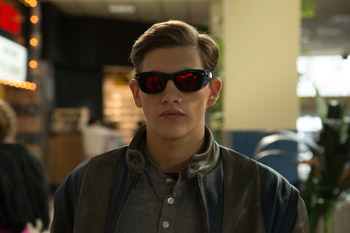 Kodi Smit-McPhee (Rise Of The Planet Of The Apes) plays the character, which the young actor believes will resonate with audiences. 'At his core, Kurt is traditional, happy, swashbuckling, joyful, as well as faithful and vulnerable," he explains.
Kodi Smit-McPhee (Rise Of The Planet Of The Apes) plays the character, which the young actor believes will resonate with audiences. 'At his core, Kurt is traditional, happy, swashbuckling, joyful, as well as faithful and vulnerable," he explains.
New to the X-Men movie universe is Jubilation Lee/Jubilee, played by Lana Condor. Jubilee has the ability to shoot pyrotechnic energy blasts from her hands. She's known for her long yellow coat, as well as her Valley Girl/mall rat personality. Jubilee is 18, and still trying to grow up and have fun, spending most of her time with Jean, Scott and Nightcrawler. Condor notes that the character 'fits perfectly into the eighties period setting. She has a fun, pop feel and like many people her age"mutant or not"she enjoys videogames."
Joining the X-Men on their quest to stop Apocalypse is Moira MacTaggert, a CIA operative. Moira was a former love interest for Charles, who erased her memory of their time together in 1962, at the height of humanity's fear and distrust of mutants, in order to protect her from attacks by anti-mutant groups.
Rose Byrne, who reprises her X-Men: First Class role, notes that despite Moira's memory loss, her connection to her mutant friends remains strong. 'Moira is in some ways an outcast," says Rose Byrne. 'She's a huge sympathizer and advocate for mutants, but the battle against Apocalypse is her priority." Still, she provides a tantalising hint of a renewed bond with Charles. 'He gives Moira the greatest gift…" is all she'll reveal.
Also returning is another human covert operative, who is Moira's polar opposite in his anti-mutant views. William Stryker is an operations specialist and military scientist bent on destroying mutants. He will go to any extreme to prevent what he sees as mutants' existential threat to humankind. Last seen in X-Men: Days Of Future Past, circa 1973, William Stryker continues his mission to rid the world of mutants. Says Josh Helman, who reprises the role: 'William Stryker is doing what he feels is necessary to save his country, but he holds such an unyielding belief in the work he's doing, that he's blind to its cost."
The World Of Apocalypse
Principal photography on X-Men: Apocalypse began on April 20, 2015 in Montréal, Quebec, Canada. The production was based at Mel's Cité du Cinema (commonly referred to as Mel's), a 27-plus acre studio facility on the Île de Montréal overlooking the St. Lawrence River. Comprised of seven soundstages totaling 116,500 square feet, the production morphed and mutated every square foot to meet its massive requirements. In addition, the team occupied numerous practical locations around the city, including several industrial sites, a derelict theatre, an old shopping mall and a cabin in the woods.
Newton Thomas Sigel embraced the opportunity to explore new visual worlds, such as Ancient Egypt, modern Egypt, Poland, East Germany and the United States in 1983. He delineated each environment in several ways, especially in terms of color. The Middle East was to have a golden, sand colored hue, where the atmosphere was imbued with gold, inspiring the feeling of heat, sand, and dryness.
Filming in Quebec at the end of the harsh Canadian winter posed an obvious challenge. For the Ancient Egyptian interiors, Newton Thomas Sigel says, 'We kept the sun filtering into the pyramid and mixed it in with flame, fire and the type of oil lighting that they would have had 4,000 years ago. Millennia later, 'Cairo is a smorgasbord of color and light with every kind of artificial and fluorescent light and the golden baked sun that we created for Egypt," says Newton Thomas Sigel.
Academy Award-winning production designer Grant Major (The Lord Of The Rings trilogy), along with his talented art department, led by supervising art director Michèle Laliberté (X-Men: Days Of Future Past) and Oscar-nominated set decorator Anne Kuljian (Divergent), had the daunting task of overseeing the design, creation and construction of the film's nearly sixty built sets, as well as the design and art direction of the movie's numerous practical locations in and around the metropolitan Montréal area.
Major's principal challenge was to re-create ancient and modern Egypt. A close second was being true to the rich design tradition of X-Men comics and the previous films. It was a matter of 'doing justice to the designers that preceded me," says Grant Major, 'along with the iconic, established designs of the X-Mansion and Cerebro, which have a highly refined look." For the Egyptian temple, the design team brought in an Egyptologist to help with the research. Major had a long list of questions, including which gods related to which Horsemen, how to represent them, and which animals matched their powers. The Egyptologist provided him with hieroglyphs, phrases that reflected the story, and elements to decorate the temple. The temple set also included four giant statues. All the hieroglyphs were drawn by hand in a smaller format and traced. They were then cut with a C & C machine 'as a drawing line on the Styrofoam boards so that our sculptors had a reference point," explains Grant Major. 'We had a large crew, all working away at panels of foam for months, carving and plastering before the painters took over. It was a good thing we started early."
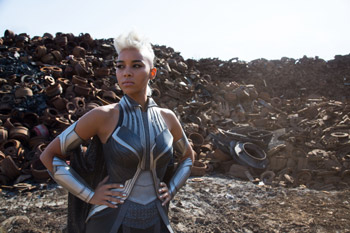 Laliberté says this film's massive scenes of destruction set it apart from its predecessors. 'The challenge of an apocalyptic plot line was making everything beautiful and then destroying it," he explains. In one of the film's biggest scenes, Apocalypse erects a new larger-than-life pyramid in the middle of 1983 Cairo. Major found an old factory about to be demolished within the city limits of Montréal. 'We literally pulled down buildings and demolished the surrounding landscape, building layer upon layer of destroyed environments," says Major.
Laliberté says this film's massive scenes of destruction set it apart from its predecessors. 'The challenge of an apocalyptic plot line was making everything beautiful and then destroying it," he explains. In one of the film's biggest scenes, Apocalypse erects a new larger-than-life pyramid in the middle of 1983 Cairo. Major found an old factory about to be demolished within the city limits of Montréal. 'We literally pulled down buildings and demolished the surrounding landscape, building layer upon layer of destroyed environments," says Major.
With the X-Mansion, Grant Major inherited artwork from production designer John Myhre, who built it for both the original X-Men film, as well as for X-Men: Days Of Future Past. Bryan Singer wanted an even bigger mansion, so Major added a two-story library, a 'student lounge," bedrooms, bathrooms and various pieces of connecting hallways. The set was converted to different floors and took up two full stages at Mel's Studios, where a wall separating two stages had to be removed to accommodate the larger mansion. This was the largest mansion set to date, built in the architectural style that Myhre had established. For the first time audiences are going to see the entire house, '360 degrees"top, bottom, sides and back," says Grant Major, 'and then we blow the whole thing up."
The grounds surrounding the mansion were planted with hundreds of trees, bushes, flowers and topiaries. In addition to the main house sets, several satellite sets were built for Quicksilver's extraction scene, including the bathroom, a couple of bedrooms, the library, and an exterior balcony. Cerebro got an eighties update as well.
One of the key scenes introducing mutants Cyclops, Jean Grey, Nightcrawler and Jubilee takes place in a shopping mall that provided a wealth of period detail. Major and his team found the perfect location: an authentic, period mall on the outskirts of Montréal that had not been renovated since the 1980s. Luckily, the owner of the property and the shopkeepers were willing let the production transform their retail spaces. Major's team emptied out the stores, bringing in props and products and completely revamping the space to look like a mall from Bryan Singer's youth. The team had researched popular commercial brands and retail outlets in American malls during the period and got permission to use their branding and logos to recreate shops like Contempo Casuals. They resurrected a video arcade and found vintage arcade machines. The arcade was born again as Space Port, which was the name of the video arcade where Singer played as a youngster.
The Polish cottage and iron factory where Magneto lives and works were idyllic, country locations scouted just outside of Montréal. The foundry was the right size and they were making molten cast items, just as the script prescribed. The cottage design called for floral motifs and, luckily, the season provided all the set decorating the production could have asked for. 'The house looked just beautiful in the early spring weather with a certain amount of color, but the foundry had graininess to it," says Grant Major. The muted color of the Eastern Europe sequences already existed at the factory location.
Character Design
The challenge in designing the special makeup effects for Apocalypse was to avoid hiding Oscar Isaac. His transformation initially took three and a half hours, but with some practice the team of two was able to bring it down to an hour and a half.
The character's makeup effects included a forehead piece, a nose and cheek piece, a jaw and chin piece, a headpiece, a neck piece and even a helmet. 'The only body part that wasn't covered was Isaac's eyeballs," jokes specialty makeup designer Brian Sipe.
'With a headdress and neck piece, as well as a twenty piece costume, the entire process was 'like a giant jigsaw puzzle," he adds. One of the prominent features in the Apocalypse design is the metallic-looking 'dreads." The challenge was making the suit 'look heroic on a normal man's body while allowing the actor to maintain mobility and conform," says Brian Sipe. They also had to keep Isaac cool in hot and humid Montreal summer weather. 'We used a system called Cool Shirt," Sipe continues. 'It's a cooling system similar to what race car drivers use; Oscar Isaac was plugged into ice water whenever he wasn't filming to maintain a comfortable temperature."
The filmmakers used a unique process to create Apocalypse's voice. Bryan Singer explains: 'It's always Oscar's voice, but during ADR, in addition to a standard Sennheiser microphone, I used a bass mic near his right cheek, and to his left cheek I used a bass drum mic, like a musician's mic, so I could pull vocal tones that would not normally be heard by the human ear. With three microphones at his face, Oscar always had to keep his head in the right spot!"
Special effects makeup department head Adrien Morot (X-Men: Days Of Future Past) and his team worked on Nightcrawler and the four Ancient Horsemen of the Apocalypse. For the Horseman 'Death" they created a look inspired by the desert and pyramids"an almost mummified, dry, cracked appearance. The skin looked like old parchment. 'Half of Death's face, hands and body was like a dry river bed," explains Morot. '[The Horseman] Pestilence resembled an aquatic creature in shades of blue with keloid scars on the face and magnificent grayish eyes. His entire head was prosthetic, so the scars were integrated. 'Pestilence was a very intimidating but beautiful character, a soothing character to look at, but he's going to kill you right after," says Adrien Morot with a laugh.
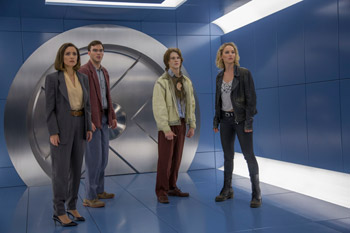 In the comics, Nightcrawler is lean, with almost feline elements: his ears have an upward slope reminiscent of a lynx, his eyes are panther-like. To stay true to the 1980s period, as well as to Alan Cumming's Nightcrawler of X2, Morot made a life casting of actor Kodi Smit-McPhee's head to produce prosthetic elements. A body cast was required to build Kodi Smit-McPhee's tail. Adrien Morot worked with MAC Makeup to formulate a special 'recipe" of matte and durable foundations in the colors that were needed to create Nightcrawler's look.
In the comics, Nightcrawler is lean, with almost feline elements: his ears have an upward slope reminiscent of a lynx, his eyes are panther-like. To stay true to the 1980s period, as well as to Alan Cumming's Nightcrawler of X2, Morot made a life casting of actor Kodi Smit-McPhee's head to produce prosthetic elements. A body cast was required to build Kodi Smit-McPhee's tail. Adrien Morot worked with MAC Makeup to formulate a special 'recipe" of matte and durable foundations in the colors that were needed to create Nightcrawler's look.
Adrien Morot's team also designed Nightcrawler's kinetic moving tail with what he says is an 'inner armature that has tension." Whenever the actor moves, the tail moves on its own. Adrien Morot was surprised at the amount of natural movement he was able to achieve without incorporating a mechanical contraption. By the end of the shooting schedule, Kodi Smit-McPhee's processing time was down to about an hour and forty-five minutes, including the application of prosthetics, makeup, teeth, eyes, body armor that supports that kinetic tail, feet and hands. 'The biggest challenges were making Nightcrawler look real and repeating it every day when he was on set," says Adrien Morot, 'and of course, satisfying the fans' ideas about what the character should look like."
Costume designer Louise Mingenbach drew upon the resources and inventory of numerous costume rental houses in the U.S. and Montréal and scoured retail vintage stores across North America to find thousands of wardrobe items needed to dress performers in 1980s apparel from Cairo, East Germany, and the U.S. She estimates the production had gathered almost 100,000 pieces of wardrobe by the end of the shoot and dressed between 2,000 and 3,000 people.
For Louise Mingenbach the most stimulating part of the process was brainstorming ideas with Bryan Singer, with whom she has collaborated seven times. "There were no restrictions, and that's when we were the most creative," she says.
Louise Mingenbach also makes special note of a procession scene set in ancient Egypt, in which 'there were Nubians carrying fans, boat carriers, the four Horsemen – and two iterations of Apocalypse," she explains. There were 30 costume dressers on set those days, working from four in the morning to get everyone ready for camera.
Apocalypse's wardrobe was one of the most difficult and detailed to build. Once Oscar Isaac was cast, all the illustrations were built off his body, taking into account details like his cheekbones and the length of his neck. During pre-production, the team went through months of testing fabrics, colors and textures. 'All the fabrics Oscar wore were created especially for the character," says Louise Mingenbach. 'We had about four months to conceive and produce a costume, and that was almost not enough time." It took two and sometimes three dressers to help the actor get the costume on and off, a process that could take upwards of 30 minutes.
The Apocalypse costume design informed those for the modern superheroes. Louise Mingenbach wanted the characters to be seen as a grouping"'warriors that are related," she says. Her team had designed Angel's wings, which were approved by Bryan Singer, but they were never built because they were too cumbersome to be practical on set. So that task was handed over to the visual effects department. Ben Hardy's costume was made out of more flexible, delicate fabrics than many of the others to facilitate enhanced movement for his flying scenes.
Bryan Singer has always insisted on drawing as many references as possible from the comic books. For Storm, Louise Mingenbach was inspired by some of Storm's comics costumes, specifically their lines, colors and references to ancient Egyptian, the ancient Horseman and the modern Horsemen. There is a strong visual correlation between Ancient Egypt and the 1983 costumes.
Olivia Munn's Psylocke costume is straight from the comic book. 'When it comes to the way she looks it was very important to me to do right by the fans," says Munn, 'because I'm a fan." The difficulty was making the costume work for her demanding action sequences. 'She's wearing practically nothing," says Louise Mingenbach. A stunt department crewperson helped to make very low-profile harnesses so that the actress could perform her stunts without a bulky old-fashioned harness underneath her. Another challenge: Munn's costume was not easy to get in and out of. 'It's like putting on a giant condom every day she filmed. It's a latex suit made by a sex shop in Los Angeles," says :ouise Mingenbach, with a laugh.
For the 1983 East Berlin sequence, Louise Mingenbach explains that 'everything was more subdued, a little held back, from the previous decade." The team dressed factory workers, doctors, Stasi police officers, ladies of the night and grandmothers. They collaborated with Grant Major to keep the pallets limited and uniform.
In Westchester, New York, the X-Mansion was all about the bright colors of 1980s America, 'replete with all the neons, stripes, and polka dots," says Mingenbach. They were inspired by the style icons of the decade, 'like Boy George, Michael Jackson and Brooke Shields." The costume designer took a slightly less saturated approach to the eighties. 'The early eighties was hard to take; there was no such thing as too much going on with fabrics and accessories, so we toned it down a bit as to not be too overly garish or distracting."
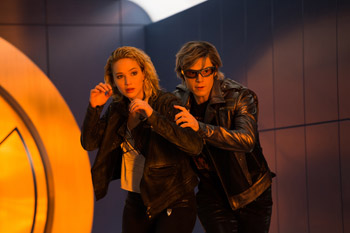 In dressing the young mutants at Xavier's school, Louise Mingenbach again stayed true to the comics. Working with Sophie Turner as Jean Grey, she took into consideration that the actress, like the comic book character, is a redhead. 'Sophie Turner is a beautiful young woman," says Louise Mingenbach, 'but at times we wanted to see her looking awkward or uncomfortable." The story opens with Jean not really knowing her place, so the clothes were chosen specifically to cover her up, make her feel protected, 'to cocoon her," says Louise Mingenbach. For much of the film, prior to the final battle sequences, she wears an oversized deconstructed men's blazer with stylised shoulder pads.
In dressing the young mutants at Xavier's school, Louise Mingenbach again stayed true to the comics. Working with Sophie Turner as Jean Grey, she took into consideration that the actress, like the comic book character, is a redhead. 'Sophie Turner is a beautiful young woman," says Louise Mingenbach, 'but at times we wanted to see her looking awkward or uncomfortable." The story opens with Jean not really knowing her place, so the clothes were chosen specifically to cover her up, make her feel protected, 'to cocoon her," says Louise Mingenbach. For much of the film, prior to the final battle sequences, she wears an oversized deconstructed men's blazer with stylised shoulder pads.
With Kodi Smit-McPhee's Nightcrawler, the first thing Louise Mingenbach tackled was an outfit he'd wear for a key sequence set in a fight club. She had found an old jacket in the throwaway pile of the 'crazy backroom" of Western Costume in Los Angeles. 'It was a stained old circus jacket with fantastic pointed tails held together by a string," says Louise Mingenbach. 'Kodi Smit-McPhee had the perfect frame for it, so we re-created the jacket and paired it with some asymmetrical eighties pants. We snuck in a little Boy George look and for his scenes at the mansion, we tried to keep Nightcrawler true to the comic, working with red and black and diagonal shapes that fans would recognise."
In dressing Julibee, Louise Mingenbach had an assortment of over 20 costumes designed for actress Lana Condor. 'I could have thrown a dart in the dark and picked one I liked," says Lana Condor. Ultimately, her wardrobe included full skirts, tights, boots, and shirts with one shoulder hanging. 'Flashdance was everywhere with Jubilee," says Louise Mingenbach.
By 1983, Professor Hank McCoy is maturing. She dons sharp yet casual suits, which Louise Mingenbach refers to as 'Beasty wear" and Singer thought resembled his own father's outfits in the eighties. Hoult was thrilled about the details of his wardrobe. 'I've got this great eighties Casio calculator watch, which comes in very handy," he jokes.
For Jennifer Lawrence, Louise Mingenbach took into account Raven's modus operandi: 'She's fighting for a cause and is not particularly concerned with how she looks," says the designer. She found Lawrence a 'Chrissie Hynde type" studded leather jacket and an old rock--n-roll t-shirt. '1983 was the great era of the rocker chick," says Mingenbach, 'and that kind of look reflected Raven's rebellious nature."
The X-Men suits had to be more than practical and 'splashy-eighties"; they had to look like something that was being developed by the military. The suits also had to look equally good on the male and female members of the team, including Hank, Moira, Raven, Quicksilver, Jean, Scott and Nightcrawler. 'That was a challenge," says Louise Mingenbach, 'figuring out what looks good on Jean Grey that looks equally good on Beast."
The Visual Effects Magician
Two-time Academy Award-winning visual effects supervisor John Dykstra has a resume long enough to fill a pyramid. His remarkable experience made for seamless transitions between the real world and the imagined. If Singer is the guru when it comes to the X-Men and their capabilities, then Dykstra is the magician who fulfills his prophecies.
'Superheroes can't do anything without visual effects," jokes John Dykstra. 'All of the X-Men powers are amplified by visual effects. We have a guy that uses sonic impact, low frequency noise to destroy his enemies; we have another who controls heat and projects thermal attacks; another who has telekinesis. Representing the various powers visually is critical to the story, showing them in a specific application and creating a sense of reality in situations that are obviously unreal."
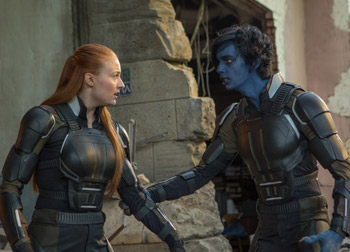 Shooting in native 3D stereo adds another dimension to the magic, so the VFX department had to deal with "the wrap," which is the ability to see around the edges of things. 'It changes how things are placed in the composition, the way things break the edge of frame, the brightness of objects to maintain detail in order for them to render as two separate eye images and have shape," explains John Dykstra. He describes the process as 'roughly like the difference between color and black and white, but no more difficult than anything else. The audience's appetite for more sophisticated images grows exponentially and the ability to keep up with that is always our biggest challenge."
Shooting in native 3D stereo adds another dimension to the magic, so the VFX department had to deal with "the wrap," which is the ability to see around the edges of things. 'It changes how things are placed in the composition, the way things break the edge of frame, the brightness of objects to maintain detail in order for them to render as two separate eye images and have shape," explains John Dykstra. He describes the process as 'roughly like the difference between color and black and white, but no more difficult than anything else. The audience's appetite for more sophisticated images grows exponentially and the ability to keep up with that is always our biggest challenge."
... A Much Bigger Film
As he puts the finishing touches on X-Men: Apocalypse, Bryan Singer notes that while his last directorial effort, X-Men: Days Of Future Past was extremely satisfying, the new film is even bigger"in several ways. 'In terms of scope and visuals, this is a much bigger movie. Days Of Future Past involved time travel, some robots, but mostly a lot of heists! This one is global destruction, godlike characters…a much bigger film. But we never lose the heart and the characters; we cling to those because they are very important. But there will definitely be a lot more spectacle this time around."
X-Men: Apocalypse
Release Date: May 19th, 2015
MORE
- Mission: Impossible Fallout
- Glenn Close The Wife
- Allison Chhorn Stanley's Mouth Interview
- Benicio Del Toro Sicario: Day of the Soldado
- Dame Judi Dench Tea With The Dames
- Sandra Bullock Ocean's 8
- Chris Pratt Jurassic World: Fallen Kingdom
- Claudia Sangiorgi Dalimore and Michelle Grace...
- Rachel McAdams Disobedience Interview
- Sebastián Lelio and Alessandro Nivola...
- Perri Cummings Trench Interview



